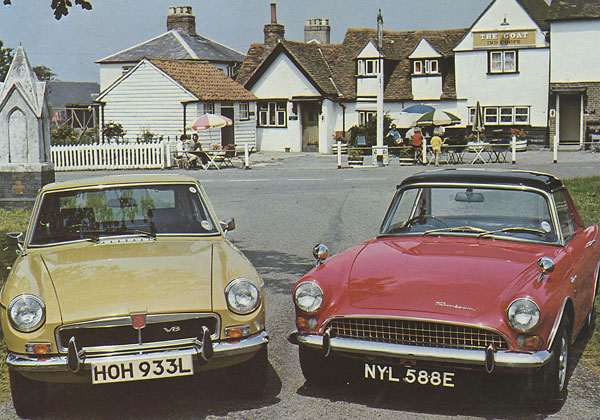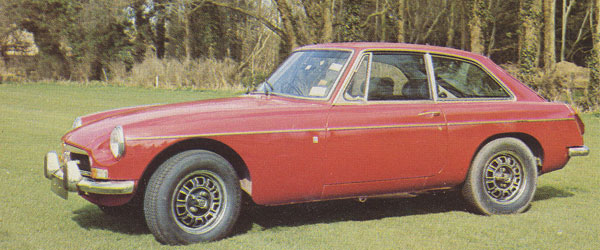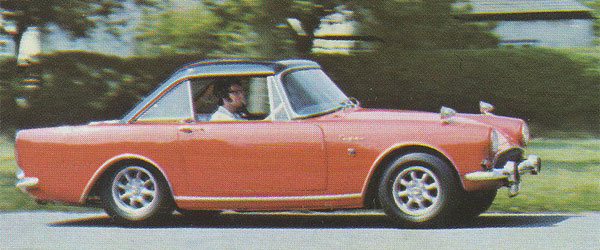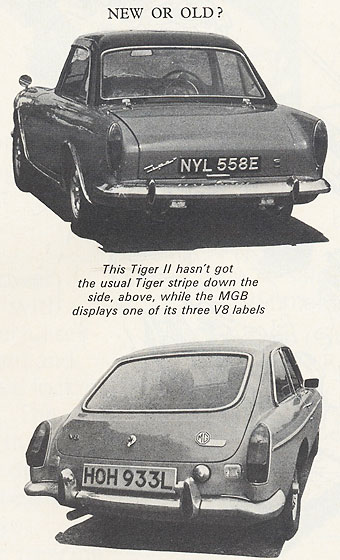�

�
A Tale of Two Vees
�1973 MGB GT (plus Rover) versus 1967 Sunbeam (plus Ford)
��
as published in BritishV8 Magazine, Volume XVII Issue 1, July 2009�
�
Re-printed unedited by exclusive written permission of "Classic Car".
�
This article originally appeared in their inaugural October 1973 issue.�
�
�
"To accept depreciation or not, that is the question. Whether 'tis nobler in �
the mind to suffer the slings and arrows of outrageous production. Or to take �
up arms against a sea of troubles and by opposing, end them."�
�
We are not too concerned with your mental nobility but more with that of your �
bank manager in this series. Not all second hand cars are likely to be a sea of �
troubles any more than current production cars are likely to pepper the mind �
with slings and arrows, but you get the picture and Shakespeare put it more �
succinctly.�
�
No excuse is needed for comparing these two. They are both professional �
shoehorn jobs the with the intention of converting mundane sports tourers �
into classic he-men sports cars. As a new car the MGB GT V8 costs £2,294; �
"our" Tiger, a rare 4.7-litre right hand drive version with hardtop, �
Minilites and Konis is priced at £1,500. The graphs of appreciation�
and depreciation will cross during the next year or two at some £1,750. �
Which do you buy?�
�
We'll start by considering them as cars on the road today. They are both �
fast; in fact the 0-60 mph time recorded by Motor for the MGB was 7.7 sec, �
while Autocar recorded 7.8 sec on the 4.7 Tiger that our Publishing Director �
Maurice Smith used to run. Maximum speeds too are very similar with the Tiger �
getting into the red at 5,500 rpm with 125 mph and the MGB hitting the same �
speed at 5,400 rpm in direct top - overdrive, giving 28.5 mph per 1,000 rpm, �
is ideal for effortless cruising but no help to more performance. The Tiger �
certainly felt as though it was still capable of the same sort of figures.�
�

�

�
�
Both are lazy cars too with Tiger torque at 282 lb/ft (gross) at 2,200 rpm �
and the MG 193 lb/ft (net) at 2,900 rpm; the MG at 211 cwt is ten per cent �
lighter than the Tigers 231 cwt so the feel is much the same. Both can pull �
easily from under 1,500 rpm; the Tigers surge of power is just a steady �
rush all the way up while the MG gets into its stride from 2,600 rpm onwards.�
�
The Tiger II gearbox had lower intermediate ratios than the original �
Tiger but it still had a higher first than the MG. Both boxes are nice �
to use with close ratios if you want the ultimate performance for �
overtaking but most of the time you stick to third gear for roundabouts. �
The Borg-Warner in the Tiger has a long travel but is no heavier to use.�
�
Bigger engines tend to be thirstier engines and the Tiger returned 15-20 �
mpg for town and country use while a 600-mile mixture with the MG gave �
23.2 mpg which could make quite a saving over a large annual mileage.�
�
Enjoying this article? Our magazine is funded through the generous support of readers like you!
�
To contribute to our operating budget, please click here and follow the instructions.
�
(Suggested contribution is twenty bucks per year. Feel free to give more!)�
� As both cars have their origins from over ten years ago - Alpine 1959 � and MGB 1962 - there isn't a lot to choose between them on styling. � Certainly the Tiger doesn't look dated against the MGB GT although � the latter is still current. Both cars are 2+vestigial 2 with the MG � having the advantage of the lift-up rear door for easy loading, but � losing to the Tiger if you want to conceal your luggage from the � public gaze. One might have expected the MGB interior to look modern � and more aware of safety padding than the Tiger, but it still uses � the same old crackle black tin fascia with a padded top while the � Tiger's wooden facia still looks attractive. The MG has a padded � steering wheel though, which is much better looking than the stock � mock-wood of the other, as well as safer. �
�| �
It's in suspension that the difference is more obvious; although both employ �
the same basic layout with a leaf sprung rear axle, the Tiger is much more �
jiggly on bumpy surfaces and could be really quite tiring on a long secondary �
road run. One would like to be able to say that the MG is a lot better, but �
whereas the ride is quieter it isn't a lot smoother over the same surfaces. �
Once on fast main roads though, the MGB is much more effortless with its �
long-legged overdrive and engine virtually inaudible up to 3,500 rpm beyond �
the note changes to a gentle thrum. The Tiger engine is as effortless but �
audible and the ride always firm, and there are one or two rattles. Steering �
on both is fairly similar, heavy but reasonably direct and both are responsive �
on their big radials.�
� There wasn't much difference in wind noise either but the Tiger hardtop � is inherently noisy while BGTs vary and the noise is thus theoretically � curable.� � The Tiger we chose came from Nostalgia at 27 London Road, Hertford Heath, � Hertsfordshire and was certainly in very good condition; it had 25,000 miles on � the clock which looked genuine from the condition of the interior and � under the bonnet. The first Tigers with the 4.2-litre Ford were shown as � Alpine 260s in October 1964; Tiger II in 1967 came as a 4.7-litre version � for export only. However a handful of the 4.7s were made with right hand � drive, about 20 out of over 600; some came from George Hartwell, some went � to the police and a few, like the one Maurice Smith ran, came out of the � Rootes development department. This car was a 1967 one. Against the 4.2 � Tiger the 4.7-litre engine gave 174 against 141 bhp, a greater increase � than that due to mere litres, so it is a little more stressed but by � European standards it is hardly working which breeds longevity. � | � � |  | �
� Just as graphs of appreciation/depreciation will cross so we need a � graph of viability against annual mileage. The Tiger is a practical � toy while the B is well set to give satisfaction over a long period; � we would reckon that around 10,000 miles a year is reasonable for the � Tiger to conserve both car and enthusiasm for it. For anything greater � you need the B with its easier serviceability and parts availability. � In fact you can still get Tiger parts and Ford engine bits but they � are getting fewer. Of course the Tiger was almost not a Rootes product � with a trimmed body from Pressed Steel, engine from Ford with a � Borg Warner manual box, Salisbury back axle and the whole lot assembled � by Jensen, so you may need to go to the original manufacturers for parts. � Some 6,500 Tiger I's were built so it may pay to get a worn out one to � keep your Tiger II going; at the moment though, there seemed to be no � suggestion that this car wouldnt keep running reliably for some time � yet. Take your pick.�
��
� BritishV8 Magazine has assembled the largest, most authoritative collection of MG � "MGB GT V8" information you'll find anywhere. Check it out! � Access our � MGB GT V8 article index by clicking here. �
�
